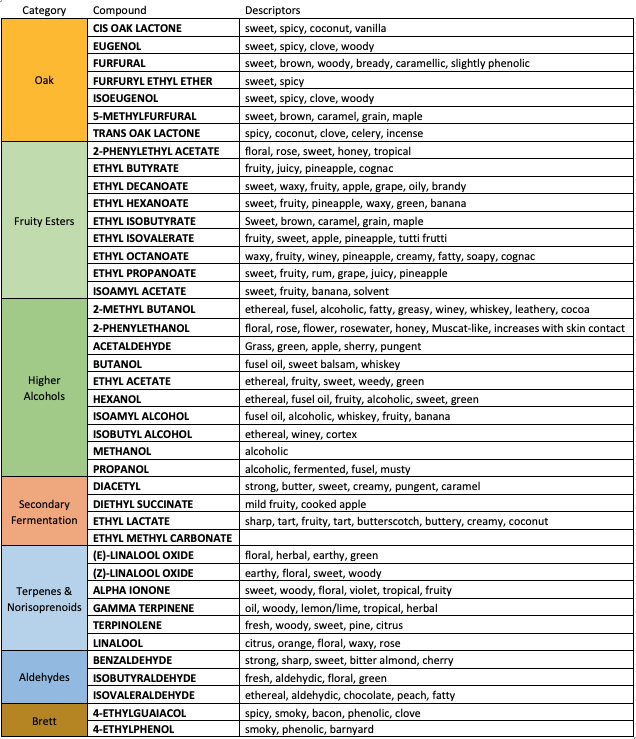How does bottling with different oxygen transmission rate screwcaps affect aging in Chardonnay and Viognier? (2015, 2022)
Kirsty Harmon
Blenheim Vineyards
Summary
There are many aspects of screwcaps that make them an excellent closure for wine bottles. Early concerns about screwcaps included the idea that wine would not evolve in the bottle during aging due to reductive conditions, however in recent years screwcap manufacturers have introduced cap types with different oxygen transmission rates, allowing the winemaker to choose a cap type with appropriate aging potential for each wine. The purpose of this trial was to test the chemical and sensory impacts of screwcaps with different OTR on Chardonnay and Viognier wines after 7 years of bottle aging. Chardonnay and Viognier from the 2013 vintage were bottled in February 2014. For each variety, wine from a single tank was bottled with Stelvin screwcaps of different OTR. Wines were first evaluated in 2015, then again in 2023. For both Chardonnay and Viognier, wines bottled with screwcaps with the highest OTR (7) showed many symptoms of oxidation: low free and total SO2, high dissolved oxygen, and measurable browning. These wines also received significantly lower sensory scores for varietal character and fruit intensity. Wines aged with OTR 1 and 3 (Chardonnay) and OTR 1, 3, and 5 showed no significant differences in sensory scores, though OTR1 wines were described as reductive by some panelists. When asked to estimate the age of these wines, those bottled with lower OTR were estimated to be less than 3 years on average, while those under OTR 7 caps were estimated to be over 6 years.
Introduction
Screwcaps are not new. This type of closure was originally patented in 1868 and developed for wine by the French company La Bouchange Mechanique beginning in the 1950’s.1 Later rollouts in Australia in the 1970’s marketed the new closure to lower the per-bottle cost of goods by $0.20-0.30. Unfortunately, early adoption of screwcaps closures for affordable wine products produced a consumer perception that screwcaps were only appropriate for lower cost wines and not higher end products.2 Screwcaps began to enjoy wider acceptance due to a united effort from several Australian wineries to jointly purchase bottles and caps for Riesling in 2000. At the time, issues plaguing cork manufacture led to up to 5% of all corks causing some amount of taint, and Riesling showed these flaws clearly. There was no manufacturer of the screwcap bottles in Australia, so producers joined together to purchase 250,000 screwcap bottles to meet the shipping threshold from France. The New Zealand Screwcap Wine Seal Initiative formed the following year.1
Early concerns about screwcaps included the idea that wine would not evolve in the bottle during aging due to reductive conditions. The original Sara-Tin liners had very little oxygen transmission, sometimes leading to reduction in the wine. For some wines, preservation of freshness is considered a benefit, while others benefit from slow oxidation reactions in the bottle. In 2014, Stelvin introduced the Inside line of screwcaps with variable oxygen transmission rates, allowing the winemaker to choose which level of oxygen ingress is right for the overall winemaking goals, release and depletion rates of each product.
There are several parts to screwcaps that contribute to their function. The outside aluminum cap provides the look of a capsule as well as threads that create a seal between the liner and the bottle. Inside the cap, the layer in contact with the wine was originally made of PVDC (polyvinylidene chloride), a relatively inert substance with little known flavor scalping. Due to environmental concerns (the PVDC made caps difficult to recycle), PVDC has been replaced with PCDC-free liners. Between the outside layer and the outside of the cap lies a 20 um layer of tin (Saran-tin) or several layers of polyethylene (Saran-ex) which determine permeability, then a 2 mm polyethylene wad to maintain compression3(Figure 1). OTR can be changed by using different amounts of PE, or alternating layers of aluminum and PE. Caps with specific OTR’s may contain aluminum portions of the liner as well.
The screwcaps used for this trial were part of the Stelvin Inside line, with oxygen transmission measured by France’s Laboratoire National de Métrologie et d’Essais:4
1: <0.0005 ccO2/day
3: 0.0005 cc O2/day
5: 0.005 ccO2/day
7: Up to 0.05 cc O2/day
Stelivin Inside Cap 1 has OTR equivalent to Sara-Tin and Cap 7 has OTR analogous to some synthetic closures. There is a 10-fold difference in OTR between each cap type.
Regardless of the cap used, some variation is still introduced during bottling based on the application and torque of the capping mechanism. Katie Cook from Scottlabs recommends quality control measures that test the removal torque, bridge break and reverse torque if possible. For smaller production, QC measures should check to make sure there is visible compression in the liner when the cap is withdrawn, indicating a good seal has been achieved.5 Screwcaps also introduce the potential for higher total package oxygen due to larger headspace volume and the introduction of oxygen in the capsule itself when applied to the bottle. Nitrogen sparging, vacuum or nitrogen drip in the headspace is recommended to displace oxygen at capping.5 This practice is common in most commercial bottling lines.
The purpose of this trial was to test the chemical and sensory impacts of screwcaps with different OTR on Chardonnay and Viognier wine. The initial report can be found on the WRE website for sensory analysis completed after 1 year of bottle aging. This report will focus on results after 7 years of bottle aging.
Figure 1: Inner lining of Stelvin screwscaps include several layers of aluminum, PE and PET. The number and material of layers determines oxygen transmission rate (from Easton 20154)
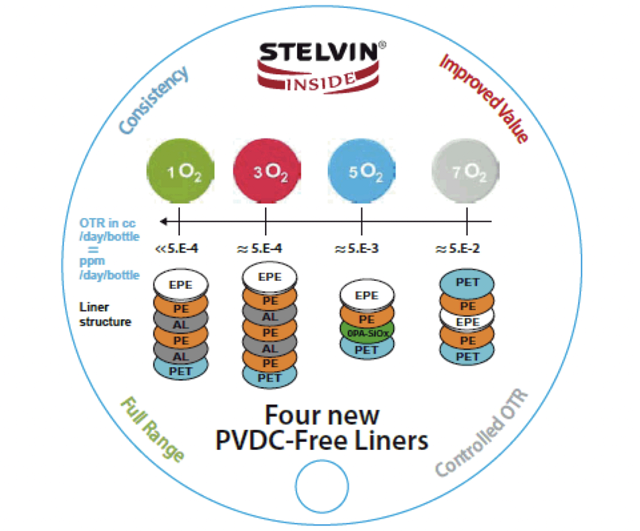
Methods
Chardonnay and Viognier from the 2013 vintage were bottled on February 23, 2014, each with a target of 0.5 ppm molecular SO2 (corresponding to 31 ppm free SO2 for Chardonnay and 34 ppm SO2 for Viognier). For each variety, wine from a single tank was bottled with Stelvin screwcaps of different OTR. For Chardonnay, types 1, 3 and 7 were used. For Viognier, types 1, 3, 5, and 7 were used.
Post bottling, wines were stored in the cellar or warehouse at Blenheim Vineyards, all under the same conditions regardless of variety or screwcap type. An initial round of chemical and sensory analysis of Chardonnay was completed in 2015. Chemical analysis of both varieties was completed in July of 2022. Sensory analysis of both wines was completed in January of 2023. Different laboratories were used for chemical analysis in 2015 vs. 2022, so care should be taken when interpreting small differences between years.
Analysis of wine chemistry as well as analysis of odor active compounds in 2022 was conducted by Tastry. Tastry uses analytical chemistry and automated feature engineering to describe the flavor matrix of wine. AI systems integrate concentrations, thresholds and interactions of hundreds of compounds found in the wine matrix to predict the overall sensory characteristics of the wine as well as how well that wine will be received by consumers. For this experiment, measured concentrations of odor active compounds were used for comparisons. AI generated predictions were not used.
At the time of sensory analysis, dissolved oxygen was measured for two bottles of each treatment using a handheld DO meter inserted into the bottle immediately after opening. Free and total SO2 were also measured at this time.
Sensory analysis of Chardonnay was completed by a panel of 20 wine producers. Wines were presented blind in randomly numbered glasses. Tasters were presented with wines aged in bottles with screwcaps of three OTRs (1, 3, and 7). Tasters were then asked to score each wine on a scale of 0 to 10 for Chardonnay varietal character, fruit intensity, reduction, and oxidation.
Table 1: Wine chemistry for Chardonnay aged under screwcaps with three oxygen transmission rates (OTR) after one year (2015) and seven years (2022)
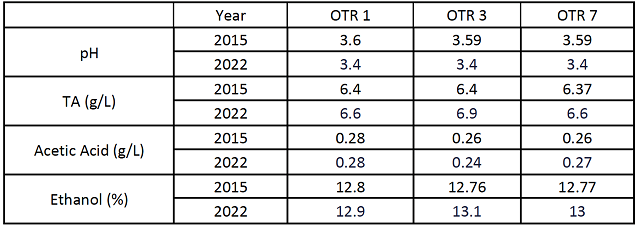
There were four tasting groups with the order of analysis balanced among groups. Tasters were also given open-ended questions to describe the wines. Descriptive scores and age estimates were analyzed using repeated measures ANOVA. If significant differences were found among scores, Tukey’s test was used to determine which categories were significantly different from one another. Sensory analysis of Viognier was conducted using the same protocol. Here, tasters were presented with wines that had been aged in bottles with screwcaps of four different OTR (1, 3, 5 and 7). In this case, tasters were asked to score each wine on a scale of 0 to 10 for Viognier varietal character, floral intensity, fruit intensity, reduction and oxidation.
Results
Chardonnay
There were no noticeable differences in wine chemistry between wines aged with different OTR screwcaps after 1 year, nor after 7 years in bottle (Table 1). Differences in values between years (rather than between cap types) are most likely due to differences in the lab used to measure these data.
Oxygen transmission into the bottle during aging will lead to the depletion of SO2. As oxygen is introduced into the wine, wine oxidizes through a series of reactions catalyzed by iron and copper. The bisulfite form of SO2 acts as an antioxidant by binding with intermediates in this pathway, stopping oxidation from occurring. These interactions consume SO2 at a rate of 4 mg/L total SO2 for every 1 mg/L of oxygen. In this way, oxidation of wine will lead to reduction in total SO2 over time.6 Therefore, wine aged with screwcaps with higher OTR would be expected to have lower total SO2 over time.
In 2015, the OTR 7 wine already showed signs of greater oxygen ingress with lower total SO2 (89 mg/L compared to 103/104 mg/L in OTR 1 and 3). This also left the wine with very low levels of free SO2 (Figure 2). A free SO2 value of at least 10 mg/L is thought to be necessary to protect wine from oxidation, so Chardonnay aged in OTR 7 screwcaps was likely already oxidized after a single year. This was the least preferred wine according to a panel of 15 winemakers tasting the wines blind (40% preferred Rate 1, 46.7% preferred Rate 3, and 13.3% preferred Rate 7). Total SO2 decreased from 2015 to 2022 for all closure types (Figure 1), however this decrease was notably larger for the wine with the OTR 7 closure, where free and total SO2 values were below the limit of detection (Imbibe Solutions).
Figure 2: Free and total SO2 (mg/L) for Chardonnay bottled with three different OTR screwcaps, measured in 2015 (unspecified lab) and 2022 (Imbibe Solutions). Values for OTR 7 in 2022 were less than 30 ppm total SO2 and less than 3 free SO2:
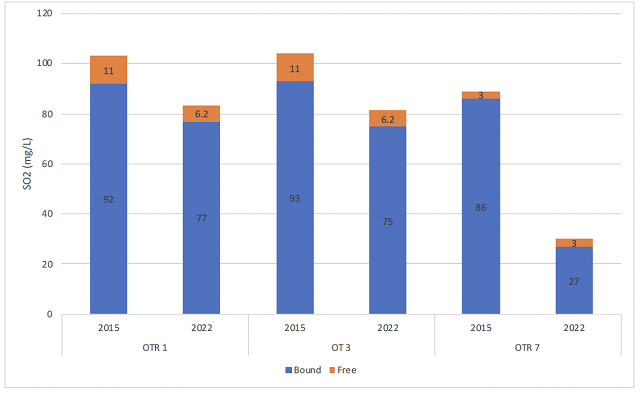
When oxidation reactions are allowed to proceed (i.e. SO2 is no longer protecting the wine), pigments in wine begin to brown. In 2022, Chardonnay bottled with OTR of 1 & 3 had the same color (FFFFE8) while the wine bottled with OTR of 7 had a moderately darker/browner color (FFFAD5)(Figure 3). Dissolved oxygen was highest for wine bottled with OTR 7 caps (0.65 mg/L), and nearly the same for wine bottled with OTR 1 and 3 caps (0.14 mg/L).
Figure 3: Color analysis of Chardonnay bottled with screwcaps of different OTR
(Tastry, July 2022)
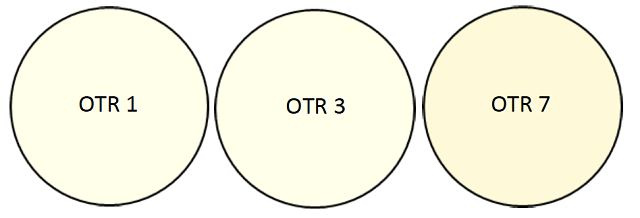
There were some differences in odor active compounds in wines aged with different OTR caps (Table 2). A list of descriptors and threshold values for these odor active compounds can be found in Appendix 1. Odor active values have been taken from published sources including AWRI, UC Davis, and others. Though there are some differences in odor active compounds between wines bottled with different types of screwcaps, none of the compounds showing notable differences was present in concentrations above threshold values.
Table 2: Comparison of odor active compounds for Chardonnay bottled with three OTR rates (Tastry, July 2022)
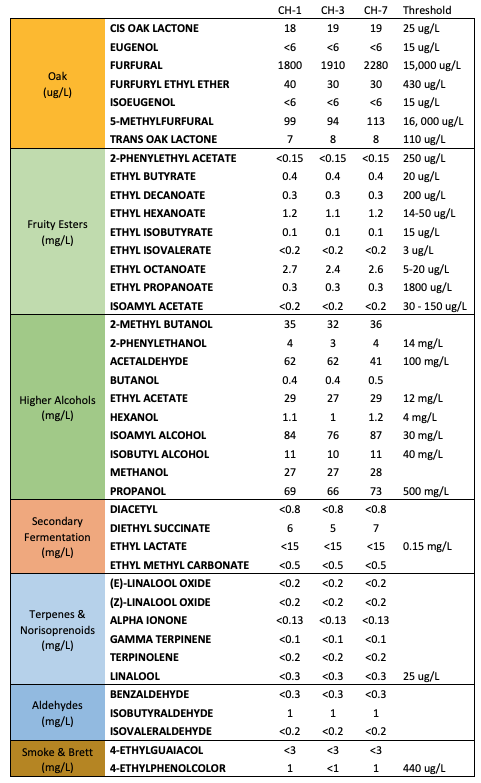
The Chardonnay wine aged with higher oxygen transmission (OTR 7 screwcap) received significantly lower sensory scores for Chardonnay varietal character and fruit intensity and significantly higher scores for oxidation while the wines aged with OTR 1 and OTR 3 screwcaps were not significantly different (Figure 4, Table 3). Winemakers were also asked to estimate time in bottle for each of the wines. The wines bottled with screwcaps with low OTR (1&3) were estimated to be just over 2 years in bottle, much younger than their actual age, while the wine aged with OTR 7 screwcap was estimated to be just over 6 years, much closer to its actual age (Figure 5).
Figure 4: Average descriptive scores for Chardonnay wines bottled and aged with three different OTR screwcaps
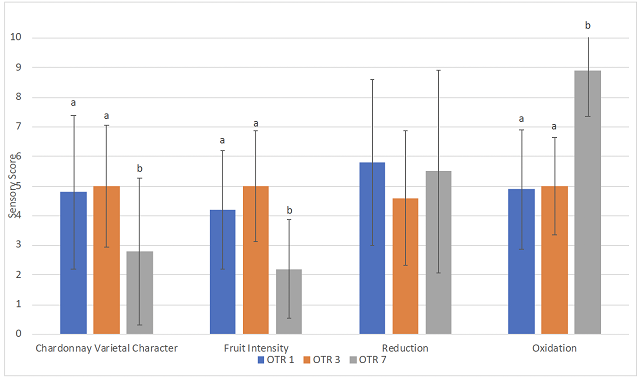
Table 3: Repeated measures ANVOA and pairwise comparisons (Tukey’s Test) of descriptive scores from sensory analysis of Chardonnay

Figure 5: Estimate Time in bottle (years) for Chardonnay aged with different OTR screwcaps
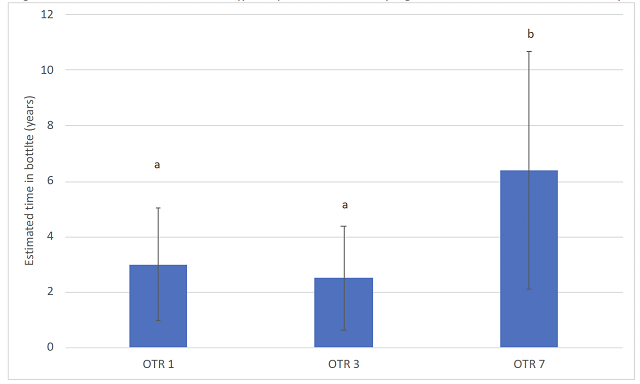
Viognier
No analysis was reported for Viognier in 2015. In 2022, there were no large differences in wine chemistry between closure types (Table 4). Free and total SO2 values were very similar for wines ages with screwcaps with OTR of 1, 3, and 5. However, as with the Chardonnay, wine aged with OTR 7 screwcaps had free and total SO2 values lower than the limit of the test (Figure 6). Increasing the OTR of the screwcap led to increased browning of the wine (Figure 7). Dissolved oxygen was also notably higher in wine bottled with OTR 7 (0.42 mg/L) relative to the other closure types (ranging from 0.08 – 0.11 mg/L). A comparison of concentrations of odor active compounds can be found in Table 5. As with Chardonnay, none of the compound with notable differences between screwcap types was present above published threshold values.
Table 4: Wine chemistry for Viognier bottled under screwcaps with four oxygen transmission rates after seven years (2022) (Tastry, Sentia, Imbibe)

Figure 6: Free and bound SO2 (mg/L) for Viognier bottled with screwcaps of different OTR (Imbibe Solutions). Values for OTR 7 were less than 30 ppm total SO2 and less than 3 free SO2.
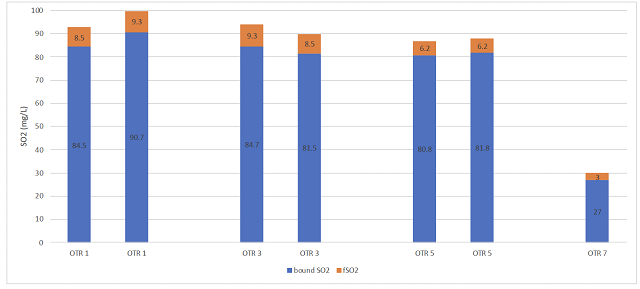
Figure 7: Color analysis of Viognier bottled with screwcaps of different OTR (Tastry, July 2022)

Table 5: Comparison of odor active compounds for Viognier bottled with different OTR
(Tastry, July 2022)
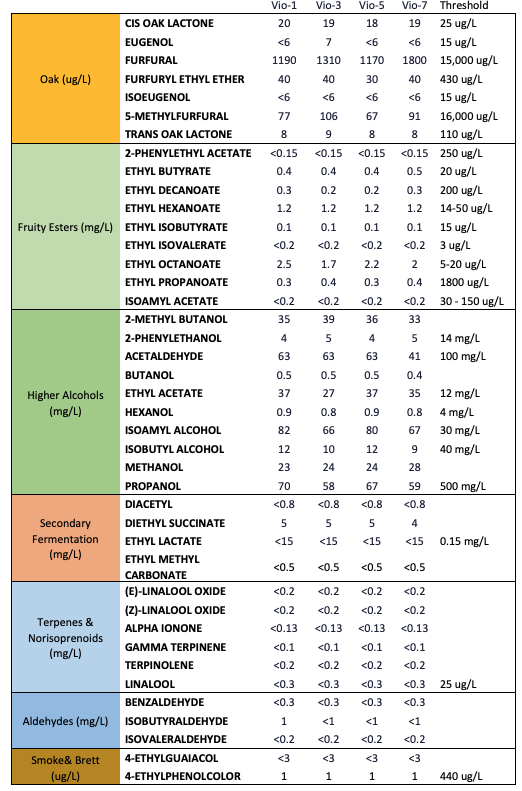
The Viognier wine aged with higher oxygen transmission (OTR 7 screwcap) received significantly lower sensory scores for Viognier varietal character, floral intensity, and fruit intensity. And significantly higher sensory scores for oxidation (Figure 8, Table 6). The Viognier aged with OTR 7 screwcaps also received significantly higher scores for reduction, which is unexpected. The wines aged with OTR 1, 3, and 5 screwcaps were not significantly different from one another using these descriptors. Winemakers were also asked to estimate time in bottle for each of the wines. The wines bottled with screwcaps with low to moderate OTR (1, 3 & 5) were estimated to be just over 2 years in bottle, much younger than their actual age, while the wine aged with OTR 7 screwcap was estimated to be nearly 7 years, much closer to its actual age (Figure 9).
Figure 8: Average descriptive scores for Viognier wines bottled and aged with four different OTR screwcaps
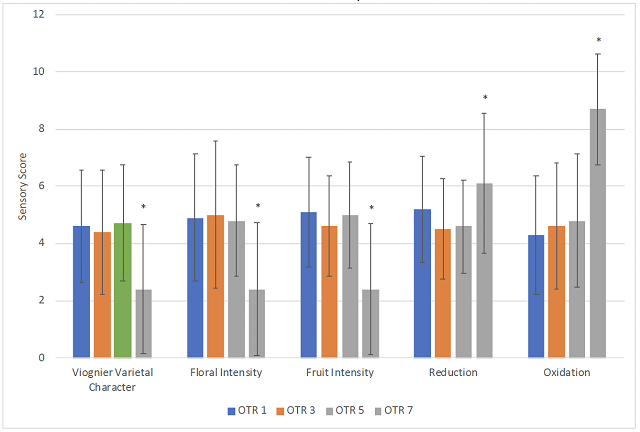
Table 6: Repeated measures ANVOA and pairwise comparisons (Tukey’s Test) of descriptive scores from sensory analysis of Viognier
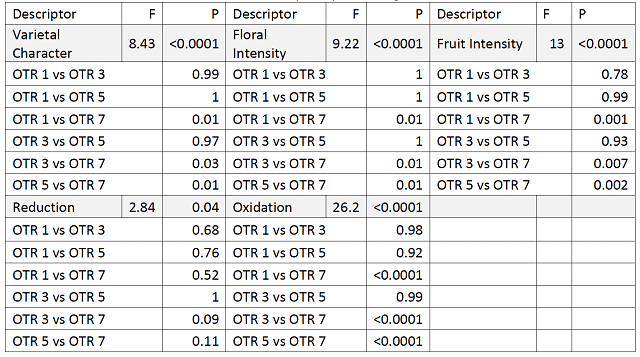
Figure 9: Estimate Time in bottle (years) for Viognier aged with different OTR screwcaps
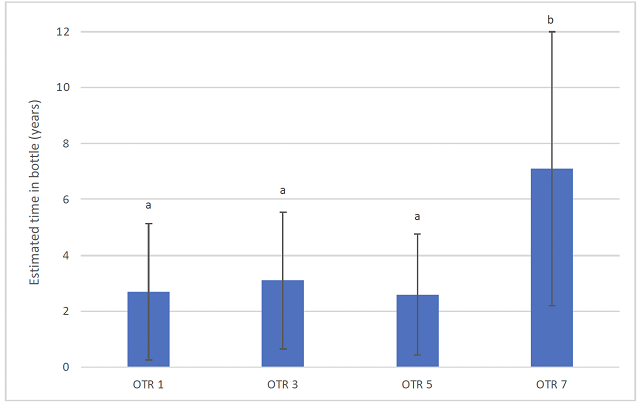
References
(1) Goode, J. The New Zealand Screwcap Initiative. Wine Anorak. https://www.wineanorak.com/new_zealand_screwcap_initiative.htm.
(2) Taber, G. M. To Cork or Not To Cork, 1st ed.; Scribner: New York, 2009.
(3) Furtado, I.; Lopes, P.; Oliveira, A. S.; Amaro, F.; Bastos, M. de L.; Cabral, M.; Guedes de Pinho, P.; Pinto, J. The Impact of Different Closures on the Flavor Composition of Wines during Bottle Aging. Foods2021, 10 (9).
(4) Easton, S. DO + HO = TPO (the new equation for successful bottling). Wine Wisdom. http://www.winewisdom.com/articles/closures/do-ho-tpo-the-new-equation-for-successful-bottling/.
(5) Bottling and Closures; Midwest Grape and Wine Industry Research and Winemaking Webinars; 2021. https://www.youtube.com/watch?v=TGquvwiahQo&list=PLfUP_JVYHQtOci2Uy7DJYx5HCtAP5COTX&index=5 (accessed 2022-07-13).
(6) Sacks, G. Oxygen and Sulfur Dioxide, Wine’s Biggest Frenemies, 2022.
Appendix 1: Sensory impacts of odor active molecules in wine (Tastry)
